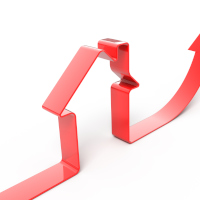Investor hotspot headed for ‘mighty price correction’
A Sydney suburb popular with investors is facing a significant price downturn in the near future, according to a prominent buyer’s agent and market commentator.

Earlier this month, wHeregroup’s Todd Hunter said those purchasing property in Sydney at the moment “are nothing short of crazy” and advised investors not to go near the market until interest rates are over seven per cent and prices have dropped “dramatically”.
This week, Mr Hunter used Castle Hill, a suburb approximately 30 kilometres north-west of Sydney's CBD, as an example of what is to come for the Sydney market. Citing statistics from CoreLogic RP Data, Mr Hunter said the suburb’s growth was not sustainable and it was 'living beyond its means'.
In September 2014, CoreLogic RP Data figures showed the median house price in the suburb to be $982,000, but Mr Hunter also provided an example of a three-bedroom unit which sold over the weekend for $920,000.
“According to RP Data [Castle Hill] has grown in value by 19 per cent in the last year and 49 per cent over the past five years,” he said. “So, in English, in 2009 you could buy in Castle Hill for $650,000.”
Mr Hunter said the average days on market for properties in the suburb is just 29 – indicating it is “still red hot” – and he anticipates the median house price will surpass the $1 million mark before Christmas.
Despite the price growth, Mr Hunter said the outlook was poor for investors and owners in the suburb who have purchased too late in the cycle and were hoping for improved returns.
“Yields have failed to keep up, like in many Sydney suburbs,” he said. “They do their best work in a quiet market where no new houses are being built and supply dries up. That said, the median rent is $650 per week. So forget investing there, with a yield of 3.4 per cent – you can achieve this in a bank without the risk. It’s one of those suburbs where it’s cheaper to rent than to purchase.”
Using figures from the 2011 Census, Mr Hunter said many owners in the area are likely to struggle when interest rates inevitably rise.
“Of all the working families, 41 per cent had one major breadwinner whilst the other partner either worked part-time or not at all. The suburb averages three people per dwelling and they own two cars.
“The median family income is $2,059 per week – that’s a tidy $107,068 per annum. But, hang on, that’s the whole household income and that’s gross. So take-home, in-hand, is $1,487 per week, at least for 41 per cent of families.”
Mr Hunter said these figures, when viewed in conjunction with property price data, paint a bleak picture for such suburbs going forward.
“Let’s stick with the median house price at $982,000. If you were to purchase with a 20 per cent deposit, you would require around a $230,000 deposit and have a loan for $785,600. With an interest rate of 4.8 per cent, the principle and interest payments would equal $951 per week over 30 years.
“That’s a whopping 63.9 per cent of your net income per week going towards your mortgage.”
Mr Hunter said if interest rates go up, or an additional child is added to the mix, families could well face bankruptcy. While he conceded he was painting a simplified picture, and said buyers may well have come in with larger deposits, the market is still on the edge.
“As the median income is the middle income achieved in the area ... there are certainly people on a higher income than $107,000. It is more than likely these people – on incomes of $135,000 or higher – who are purchasing properties at this level. But let’s go crazy and pretend interest rates will go up to eight per cent… Can they afford to make the loan repayments?
“A $785,000 principle and interest loan at eight per cent would be $1,329, which equates to 73 per cent of their income – leaving $485 per week to feed a family of three, fuel for two cars, rego, council and water rates, alcohol and possibly cigarettes, bills, school fees.
“So, it could potentially be done, but you would be living on bread and water – and in reality, this family would go bankrupt.”
Mr Hunter said this scenario would become increasingly common in suburbs such as Castle Hill in the coming years.
“The numbers are leaning towards a suburb that is living well beyond its means and I would say that there is a little bit of ‘keeping up with the Joneses’ going on here too.
“And that’s a recipe for one mighty price correction.”